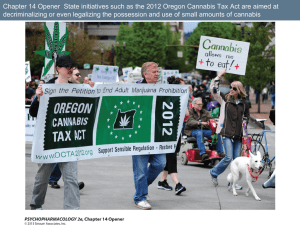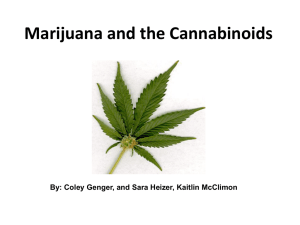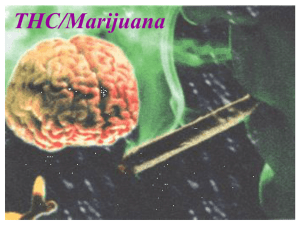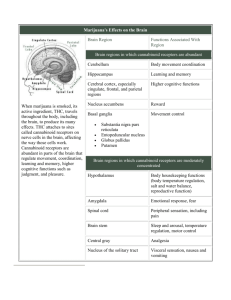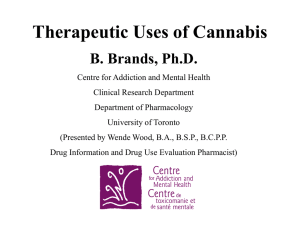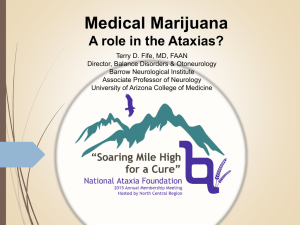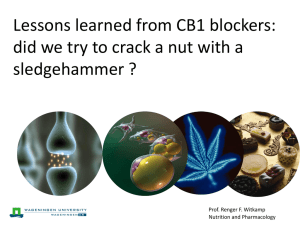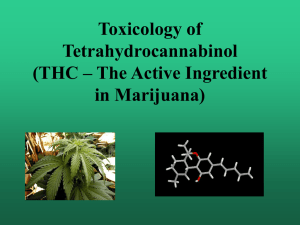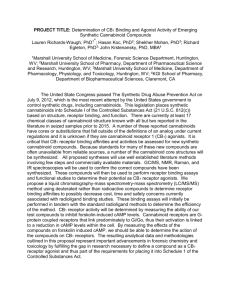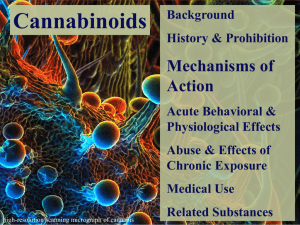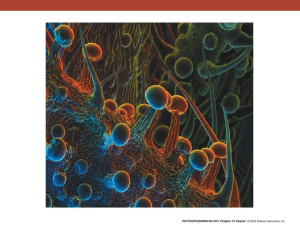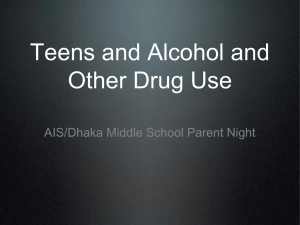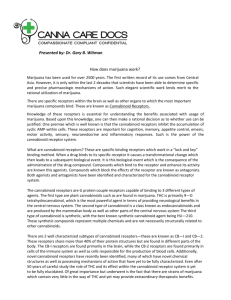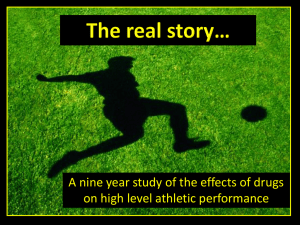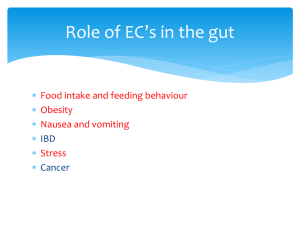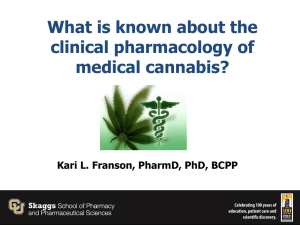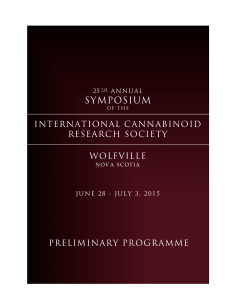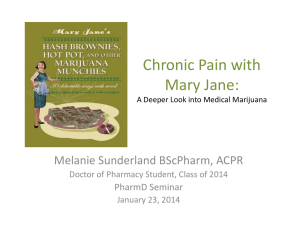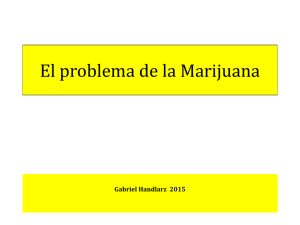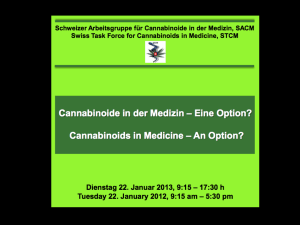704 Marijuana - University Psychiatry
advertisement
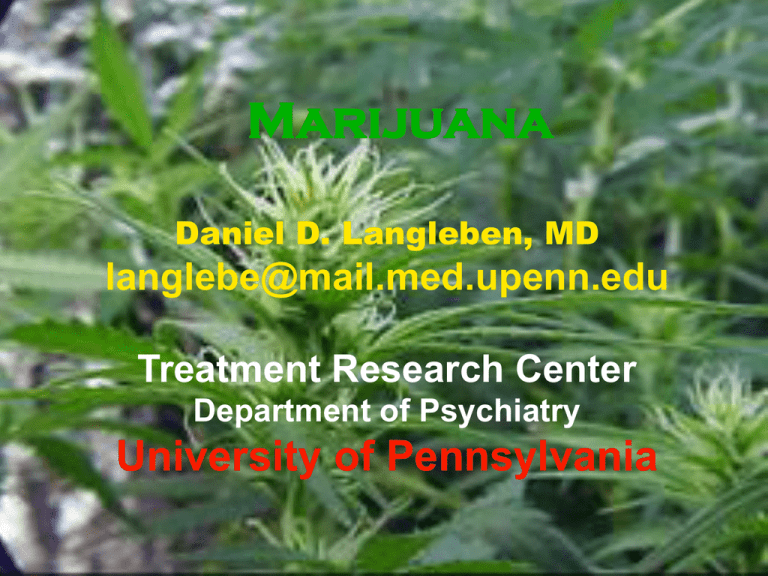
Marijuana Daniel D. Langleben, MD langlebe@mail.med.upenn.edu Treatment Research Center Department of Psychiatry University of Pennsylvania Marijuana = Dried and shredded Cannabis sativa (hemp) • Native of Central Asia, now worldwide • Blooming buds of the female plants: highest concentration of THC • Smoked (joints, bongs and blunts) or eaten Clinical effects - cognitive Desirable • Euphoria : “high” • Anxiolysis: “mellowing out” Toxic • Balance and orientation • Motivation • Memory • Perception • Consciousness Clinical effects - somatic Therapeutic • Antiemetic • Reduction of intraocular tension • Analgesic • Muscle relaxant • Anti-convulsant • Anti-inflammatory • appetite: “the munchies” Toxic • Xerostomia,Hypohydrosis, Hypertension,Tachycardia • Conjunctival Irritation • Bronchopulmonary Irritation • Endocrine changes • Immunomodulation • LD 50% in rats > 1200 mg/kg Are canabinoids like other drugs of abuse? Preclinical data: YES Clinical data: ? • Tolerance rapid on/off • Withdrawal syndrome: atypical, mild • Dependence: 9% of those who ever used Le Foll & Goldberg 2005 Is self administered THC seeking can be reinstated over delay CRF & BSR (“brain stimulation reward”) Dopamine Produces Conditioned Place Preference (CPP) Chemical constituents of Chemical classes Cannabis Cannabinoids (66) Nitrogenous compounds (27) Amino acids(18) Proteins/ enzymes (11) Sugars (34) Hydrocarbons (50) Simple alcohols (7) Simple aldehydes (12) Simple ketones (13) Simple acids (21) Fatty acids (22) Simple esters/lactones (13) Steroids (11) Terpenes (20) Non-cannabinoid phenols (25) Flavoroids (21) Vitamins (1) Pigments (2) Elements (9) Total known compounds (483) Delta-9-tetrahydrocannabinol (THC) is the active ingredient of marijuana major metabolites OH-THC (11-delta-9-THC) and THC-COOH (11-nor-delta-9-THCcarboxylic acid, inactive) Levo is the more active isomer THC OH O 11-OH-THC (active) Epidemiology: The Demand Most common illicit psychoactive drug worldwide 94 million Americans (40 %) over 12 have tried marijuana (National Survey on Drug Use and Health, 2003) http://www.marijuana-info.org THC Content in street preparations > 4% Marijuana 30% Hashish $10 billion spent in the US in 2000 $70 to $1,200 per pound, $600 to $4,000 for sin-semilla The Supply All 50 States, Puerto Rico and Guam reported cannabis cultivation Indoor hydroponic operations in every State and Puerto Rico Major foreign sources: Mexico (7900 metric tons), Canada, Colombia, and Jamaica (200 metric tons) ONDCP Absorption, Metabolism & Elimination Psychotropic threshold > 25 ng/ml Peak plasma levels > 100 ng/ml drop to < 2 ng/ml in 4 hours Psychotropic effects lag the plasma level after inhalation Peak effect (inhaled) <10 min Peak effect (ingested) 2.5+ hrs (first pass yields OH-THC) Liver - CYT P450 Lipophilic: redistributed in fatty tissues and could be released back into circulation Elimination: 35% urine, 65% feces Detection • Screening - Immunoassay in urine: sensitivity threshold is 50 ng/ml, does not discriminate THC from the metabolites • Confirmation - Gas chromatography and other specific methods • Single joint can lead to a positive urine test for 8-96 hrs • Plasma but not urine samples are correlated with time and amount used MMWR Weekly September 16, 1983 / 32(36);469-71 NHTSA Fact sheet 2002 THC and metabolites in plasma and urine 120 THC (ng/ml) 100 OH-THC THC-COOH urine 80 60 40 20 -20 183 176 169 162 155 148 141 134 127 120 113 106 99 92 85 78 71 64 57 50 43 36 29 22 15 8 1 0 1930: American Cannabis USP “narcotic,analgesic,sedative…” Parke, Davis and Co 2006: Sativex™ oral and spray GW pharmaceuticals (UK/Canada) May I prescribe you a joint? 11 states legalized medicinal use with medical recommendation: AK AZ CA CO HI ME NV OR RI VT WA 35 states allow use by prescription BUT Schedule I substance under the Controlled Substances Act: high potential for abuse, no currently accepted medical use and a lack of accepted safety = illegal, except FDA - approved research programs so Synthetic Cannabinoid Agonists • Dronabinol (Marinol): Synthetic THC FDA-approved for nausea associated with chemotherapy and for AIDS-related wasting • Nabilone (Cesamet): THC analogue Same indications as Marinol (UK) • HU-210: x100 to 800 more potent than THC • WIN-55,212-2: Binds to CB2 > CB1 Cannabinoid Receptors G protein-coupled, with seven transmembrane regions • CB1 Brain, fat cells, liver, duodenum, muscle • CB2 lymphocytes>macrophages>cytokines Endocannabinoids: Bind CB1 > CB 2 structure, related to prostaglandins • Annandamide (arachidonyl-ethanolamid) • 2-Arachidonoyl glycerol (2-AG) more abundant, less potent Nicoll & Alger, 2004 CB1 receptors in the brain Dense:Basal Ganglia, Cerebellum, Hippocampus, NAcc, Middle Prefrontal and Parietal Cortex Moderate: Amygdala, Spinal Cord, Brainstem Nicoll & Alger, 2004 Depolarization-induced suppression of inhibition POSTSYNAPTIC endocannabinoid release inhibits PRESYNAPTIC GABA and glutamate release Nicoll & Alger, 2004 Synthetic Cannabinoid Antagonists SR 141716A (RIMONABANT, Phase 3 trials) AM 281, AM 251 = CB1 SR 144528 = CB2 CB1 antagonists Rimonabant SPECT ligand Volkow 2004 Obesity = Hyperactive endocannabinoid system? Endocannabinoids and cannabis • Induce appetite (orexigenesis) • Reduce satiety • Stimulate lipogenesis • Reduce energy expenditure • Increase hedonic reward value of palatable food A CB1 antagonist should have opposite effects… Therapeutic potential of CB1 antagonists for substance abuse indications Blocks the direct reinforcing effects of some drugs of abuse and food Blocks the motivational effects (relapse prevention) of most drugs of abuse Preclinical: SR141716 blocked conditioned place preference and reinstatement of drug seeking behavior to heroin and nicotine but not cocaine (De Vries et al 2001) Clinical: Rimonabant doubled smoking quit rates Conclusions • Marijuana delivery system (the “joint”) is more harmful that the substance itself (1999 IoM report) • Relative to other illicit and legal psychoactive substances, the abuse and addictive potential of cannabinoids is modest • Once separated from marijuana, cannabinoid agonists are a promising new class of compounds for a variety of non-psychiatric indications • Cannabinoid antagonists are a potentially important new class of compounds for the treatment of the disorders of motivation and reward system that include drug addiction, drug abuse Selected references: • Substance Abuse and Mental Health Services Administration. Results from the 2003 National Survey on Drug Use and Health: National Findings. NSDUH Series H-25. DHHS Pub. No. (SMA) 04-3964. Rockville, MD: SAMHSA, 2004. • Arendt, M., R. Rosenberg, et al. (2005). "Cannabis-induced psychosis and subsequent schizophrenia-spectrum disorders: follow-up study of 535 incident cases." Br J Psychiatry 187: 510-5. • Bolla, K. I., K. Brown, et al. (2002). "Dose-related neurocognitive effects of marijuana use." Neurology 59(9): 1337-43. • Di Marzo, V. and I. Matias (2005). "Endocannabinoid control of food intake and energy balance." Nat Neurosci 8(5): 585-9. • Marx, J. (2006). "Drug development. Drugs inspired by a drug." Science 311(5759): 322-5. • di Tomaso, E., M. Beltramo, et al. (1996). "Brain cannabinoids in chocolate." Nature 382(6593): 677-8. • Fernandez, J. R. and D. B. Allison (2004). "Rimonabant Sanofi-Synthelabo." Curr Opin Investig Drugs 5(4): 430-5. • Marx, J. (2006). "Drug development. Drugs inspired by a drug." Science 311(5759): 322-5. • Mechoulam, R. (1970). "Marihuana chemistry." Science 168(936): 1159-66. • Monteleone, P., I. Matias, et al. (2005). "Blood levels of the endocannabinoid anandamide are increased in anorexia nervosa and in bingeeating disorder, but not in bulimia nervosa." Neuropsychopharmacology 30(6): 1216-21. • Piomelli, D. (2004). "The endogenous cannabinoid system and the treatment of marijuana dependence." Neuropharmacology 47 Suppl 1: 35967. • Di Marzo V, Petrocellis LD. Plant, synthetic, and endogenous cannabinoids in medicine. Annu Rev Med. 2006;57:553-74. • Piomelli, D. (2005). "The endocannabinoid system: a drug discovery perspective." Curr Opin Investig Drugs 6(7): 672-9. • Thornton-Jones, Z. D., S. P. Vickers, et al. (2005). "The cannabinoid CB1 receptor antagonist SR141716A reduces appetitive and consummatory responses for food." Psychopharmacology (Berl) 179(2): 452-60. • Marsicano G, Wotjak CT, Azad SC, et al. The endogenous cannabinoid system controls extinction of aversive memories. Nature. 2002 Aug 1;418(6897):530-4. van der Stelt, M. and V. Di Marzo (2003). "The endocannabinoid system in the basal ganglia and in the mesolimbic reward system: implications for neurological and psychiatric disorders." Eur J Pharmacol 480(1-3): 133-50. •

